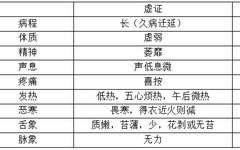Section Four: Deficiency and Excess
Key Point One: Concept and Clinical Manifestations of Deficiency Syndrome
1. Concept
Deficiency syndrome refers to the condition where the body’s vital energies such as Yin, Yang, Qi, Blood, Body Fluids, and Essence are insufficient, while pathogenic factors are not prominent, manifesting various symptoms characterized by insufficiency, relaxation, and decline.
2. Clinically, deficiency syndrome is generally seen in chronic illnesses, cases with slow progression, excessive consumption, and individuals with weak constitutions.
3. Classification
(1) Exterior Deficiency Syndrome: Can be divided into exterior pathogenic deficiency and internal injury deficiency.
(2) Exterior Pathogenic Deficiency: Symptoms include headache, stiff neck, fever, sweating, aversion to wind, and a floating and relaxed pulse.
(3) Internal Injury Deficiency: Symptoms include spontaneous sweating, susceptibility to colds, pale complexion, shortness of breath, wheezing upon exertion, fatigue, poor appetite, loose stools, pale tongue with white coating, and a thin and weak pulse, indicating Qi deficiency.
(4) Interior Deficiency Syndrome: This can be further divided into deficiency cold syndrome and deficiency heat syndrome based on cold and heat differentiation.
(5) Deficiency Cold Syndrome and Deficiency Heat Syndrome (see cold-heat differentiation).
Key Point Insights: This key point requires a strong grasp as it has a high probability of being tested. Understanding this syndrome type aids in learning organ differentiation. Additionally, attention should be paid to the differentiation between various types of deficiency syndromes.
Key Point Two: Analysis of Symptoms in Deficiency Syndrome
1. The causes of deficiency syndrome can arise from congenital insufficiency, but mainly result from acquired imbalances and disease consumption. For example, dietary imbalances lead to insufficient nourishment of Qi and Blood; excessive thinking, grief, fear, and overexertion can deplete Qi and Blood; irregular sexual activity can consume Kidney Essence; prolonged illness without proper treatment can damage vital Qi; excessive vomiting, diarrhea, sweating, bleeding, and loss of essence can all lead to deficiency syndrome.
2. The pathogenesis of deficiency syndrome mainly manifests as damage to Yin or Yang.
(1) Yang Damage: Characterized by symptoms of Yang Qi deficiency. Due to the loss of Yang’s warming and consolidating functions, symptoms may include pale complexion, cold limbs, fatigue, palpitations, shortness of breath, loose stools, urinary incontinence, etc. Yang deficiency leads to excess cold in Yin, hence a swollen and tender tongue, and a weak and slow pulse.
(2) Yin Damage: Characterized by symptoms of Yin and Blood deficiency. Due to Yin’s inability to restrain Yang and its loss of nourishing and moistening functions, symptoms may include heat in the palms and soles, irritability, palpitations, sallow or flushed complexion, tidal fever, and night sweats. Yin deficiency leads to excess Yang, hence a red, dry tongue with little coating, and a thin, rapid pulse.
Key Point Insights: This key point requires understanding; mastering the analysis of deficiency syndrome symptoms can aid in memorizing clinical manifestations, but the likelihood of direct examination on this point is low.
Key Point Three: Excess Syndrome
1. Concept
Excess syndrome refers to the condition where the body is invaded by external pathogens, or during the disease process, there is an imbalance of Yin, Yang, Qi, and Blood, leading to the accumulation of pathological products within the body. The basic pathology is characterized by excess pathogenic factors and intact vital Qi, manifesting various symptoms characterized by excess, exuberance, and accumulation.
2. Clinically, new onset or acute diseases are often excess syndromes, and those with rapid disease progression are more likely to present with excess syndromes, as are individuals with robust constitutions.
(1) Exterior Excess Syndrome: Refers to symptoms arising from external pathogens invading the body, with Yang Qi concentrated at the surface, leading to a struggle between the righteous and the pathogenic, and symptoms of closed pores. Clinical manifestations include symptoms of exterior syndrome, with the characteristics of no sweating, pain in the head and body, and a floating and tight pulse. This is commonly seen in exterior cold syndrome due to external cold invasion.
(2) Interior Excess Syndrome: This can be further divided into excess cold syndrome and excess heat syndrome based on cold and heat differentiation.
(3) Excess Cold Syndrome and Excess Heat Syndrome (see cold-heat differentiation).
Key Point Insights: This key point is foundational and requires a strong grasp as it has a high probability of being tested. Additionally, attention should be paid to its differentiation from deficiency syndrome.
Table 7-4 Differentiation between Deficiency and Excess Syndromes

Key Point Four: Analysis of Symptoms in Excess Syndrome
1. The causes and mechanisms can be summarized into two aspects:
(1) External pathogens such as wind, cold, heat, dampness, dryness, fire, epidemics, and toxins invade the body, prompting the righteous Qi to resist the pathogens, leading to symptoms that are more exuberant and urgent, with significant cold-heat manifestations, severe pain, or pronounced vomiting, diarrhea, cough, and wheezing, as well as obstructed urination and a solid pulse.
(2) Dysfunction of internal organs leads to impaired Qi transformation, Qi stagnation, resulting in the formation of tangible pathological substances such as phlegm, fluids, dampness, pus, blood stasis, and food stagnation, which accumulate within the body. Wind, cold, heat, dampness, dryness, and toxins are considered diseases, while phlegm obstruction, fluid retention, water overflow, food accumulation, parasitic accumulation, Qi stagnation, blood stasis, and pus toxicity are generally categorized under excess syndrome.
Key Point Insights: This key point requires understanding; mastering the analysis of excess syndrome symptoms can aid in memorizing clinical manifestations, but the likelihood of direct examination on this point is low.
01
Among the following, which is not a typical manifestation of excess syndrome? (Single choice)
A. Abdominal distension
B. Abdominal pain with hardness
C. Purple tongue
D. Thick and greasy tongue coating
Click the blank area to view the answer
[Answer Explanation]: A. Excess syndrome refers to the condition where the body is invaded by external pathogens, or during the disease process, there is an imbalance of Yin, Yang, Qi, and Blood, leading to the accumulation of pathological products within the body. Abdominal distension often occurs due to spleen deficiency and loss of function, thus belongs to deficiency syndrome (A is incorrect, this is the correct answer for this question). Abdominal pain with hardness is often due to the accumulation of excess pathogenic factors, thus belongs to excess syndrome (B is correct). A purple tongue often indicates heat and blood stasis, thus belongs to excess syndrome (C is correct). A thick and greasy tongue coating often indicates dampness, phlegm, or food accumulation, thus belongs to excess syndrome (D is correct).
02
Among the following options, which does not belong to the manifestations of excess heat syndrome? (Single choice)
A. High fever with aversion to heat
B. Flushed cheeks
C. Constipation with yellow urine
D. Red tongue with yellow coating
Click the blank area to view the answer
[Answer Explanation]: B. This question examines the clinical manifestations of excess heat syndrome. Flushed cheeks are caused by Yin fluid deficiency and internal heat, thus belong to manifestations of deficiency heat (B is incorrect, this is the correct answer for this question). Excess heat syndrome often arises from external heat invasion, excessive consumption of spicy and warming foods, or excessive internal Yang heat, leading to rapid onset, especially in robust individuals. Due to the predominance of Yang heat, body fluids are consumed, or due to Yin fluid deficiency leading to excess Yang, symptoms include fever, aversion to heat (A is correct), flushed face, restlessness, red tongue, yellow coating (D is correct), and rapid pulse, etc.; heat injures Yin fluids, leading to thirst, desire to drink, yellow and thick phlegm, short yellow urine, and dry stools (C is correct), with a dry tongue and little fluid.
03
The main characteristics of deficiency cold syndrome include (multiple choice)
A. Whole body chills
B. Aversion to cold with cold limbs
C. Aversion to wind and cold
D. Preference for warmth and pressure
Click the blank area to view the answer
[Answer Explanation]: BCD. Deficiency cold syndrome is caused by the deficiency of Yang Qi within the body, leading to Yang deficiency and cold. The deficiency of Yang Qi results in insufficient warming and Qi transformation, hence aversion to wind and cold (C is correct); insufficient Yang Qi leads to aversion to cold with cold limbs (B is correct), and preference for warmth and pressure (D is correct). Whole body chills are characteristic of excess cold syndrome, where cold pathogens obstruct Yang Qi, leading to chills (A is incorrect).


Submission Email:
Beginner Medical Exam, Making TCM Graduate Studies Easy
Long press the QR code to follow us

